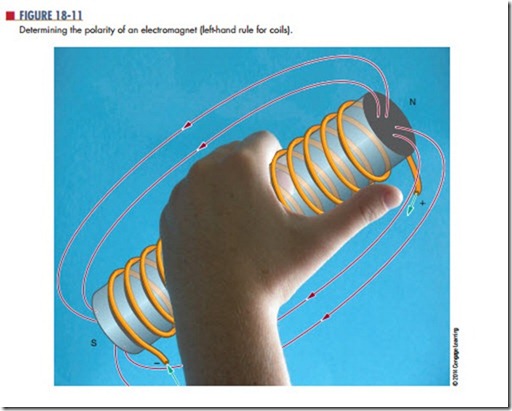electricity and Magnetism
When current flows through a wire, it generates a magnetic field around the wire (Figure 18-7). This can be shown by placing a compass next to a wire that has no current flowing through it. The compass aligns itself with the earth’s magnetic field. When cur- rent passes through the wire, however, the compass needle is deflected and aligns itself with the magnetic field generated by the current. The north pole of the compass indicates the direction of the flux lines. The direction of the flux lines can also be determined if the direction of the current flow is known, using the left-hand rule for conductors. If the wire is grasped with the left hand, with the thumb pointing in the direction of current flow, the fingers point in the direction of the flux lines (Figure 18-8). When the polarity of the voltage source is reversed, the flux lines are also reversed.
If two wires are placed next to each other with current flowing in opposite directions, they create opposing magnetic fields that repel each other (Figure 18-9). If the two wires carry current flowing in the same direction, the fields combine (Figure 18-10).
A single piece of wire produces a magnetic field with no north or south pole and little strength or practical value. If the wire is twisted into a loop, three things occur: (1) The flux lines are brought together.
(2) The flux lines are concentrated at the center of the loop. (3) North and south poles are established. This is the principle of the electromagnet.
An electromagnet is composed of many turns of wire close together. This allows the flux lines to add together when a current flows through the wire. The more turns of wire, the more flux lines are added together. Also, the greater the current, the greater the number of flux lines generated. The strength of the magnetic field, then, is directly proportional to the number of turns in the coil and the amount of current flowing through it.
A third method of increasing the strength of the magnetic field is to insert a ferromagnetic core into the center of the coil. An iron core is typically used be- cause it has a higher permeability (can support more flux lines) than air.
Use the left-hand rule for coils to determine the polarity of the electromagnet; grasp the coil with the left hand, with the fingers pointing in the direction of the current flow. The thumb then points in the direction of the north pole (Figure 18-11).
Questions
1. How can a magnetic field be shown to exist when a current flows through a wire?
2. How can the direction of flux lines around a wire be determined?
3. What happens when two current-carrying wires are placed next to each other with the current flowing in:
a. the same direction?
b. Opposite directions?
4. What are three ways to increase the strength of an electromagnetic field?
5. How can the polarity of an electromagnet be determined?

